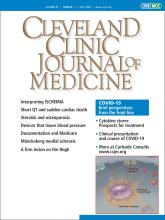In healthy people without symptoms, a short QT interval by itself does not necessarily increase the risk of sudden cardiac death and may in fact be a normal variant. However, it may warrant further investigation to determine if the patient is at risk.1–3
CORRECTING THE QT INTERVAL
The corrected QT interval (QTc) should be calculated. However, this should not be done when the patient is in tachycardia or bradycardia (using long-term electrocardiographic monitoring or beta-blockers if needed) to prevent the use of the Bazett formula at heart rates in which its correction is not linear and may lead to overestimation or underestimation of QTc values.2 Furthermore, in patients with short QT syndrome, the physiologic abbreviation of the QT interval during tachycardia can be blunted (pseudonormalization of the QT interval) with failure to prolong the QT interval at slower heart rates, which contributes to the poor performance of correction formulas with heart rates above 100 beats/min or below 60 beats/min.
WHAT IS NORMAL?
The definition of the lower limit of the normal QT interval is a matter of debate. Mason et al4 analyzed the electrocardiograms of 79,743 healthy people (including babies and children) and found that a QTc value 2 standard deviations below the mean was 350 ms in males and 360 ms in females. Many cardiac society guidelines deem that a QTc less than those values should be considered short, and a QTc interval less than 330 to 340 ms should be considered extremely short.1,2,4,5
Applying the cutoff of 2 standard deviations, the prevalence of a short QT interval is around 2%.4 Although this cutoff is sensitive, it takes in a large number of people who are not really at risk, and it does not necessarily predict arrhythmogenic potential.6
Proposed diagnostic criteria for short QT syndrome
The threshold of 360 ms is considered diagnostic of short QT syndrome if it is accompanied by 1 or more of the following:
Pathogenic mutation
Family history of short QT syndrome
Family history of sudden death before age 40
Survival of an episode of ventricular tachycardia-ventricular fibrillation (VT-VF) in the absence of heart disease.
Most experts agree that even without any of these factors, a QTc shorter than 330 to 340 ms is diagnostic of short QT syndrome, as such values are very rare in a healthy population.
DIFFERENTIAL DIAGNOSIS
Diagnosing short QT syndrome can be challenging, owing to the overlapping QT range of at-risk and healthy populations. Patients with short QT syndrome with normal QT interval have been reported, but in most cases, the QTc interval is less than 360 ms.
Assess for acquired causes first
Acquired causes of short QT interval should be considered first. Potential causes of nongenetic QT shortening include:
Hypercalcemia, hyperkalemia, acidosis, and hyperthermia7
Drug effects, eg, from digitalis,8 nicorandil (through activation of adenosine triphosphate [ATP]-sensitive potassium channels),9 isavuconazole (through inhibition of L-type calcium channels),10 and lamotrigine9
Effect of acetylcholine and increased vagal tone, through activation of acetylcholine-sensitive potassium channels. This leads to deceleration-dependent shortening of the QT interval (ie, paradoxical QT interval shortening with a decrease in heart rate instead of lengthening)11
Effect of catecholamines, through beta-adrenoceptor-induced activation of ATP-sensitive potassium channels12
Myocardial ischemia through activation of ATP-sensitive potassium channels12
Ventricular fibrillation, possibly related to increased intracellular calcium13
Androgen use.14
Genetic causes
After considering possible acquired causes of short QT syndrome, the proposed diagnostic criteria discussed above should be satisfied before evaluating for a genetic cause.1,2,6
Short QT syndrome can be caused by a rare inherited genetic channelopathy associated with markedly shortened QT intervals and a structurally normal heart. Electrocardiography usually shows short or absent ST segments, tall and narrow T waves, marked shortening of the interval from the J point to the T peak (< 120 ms), and the signature sign of short QT intervals in the precordial leads.
Ion channel defects associated with short QT syndrome may be caused by mutations in potassium channels (KCNH2, KCNQ1, KCNJ2), calcium channels (CACNA1C, CACNB2, CAC-NA2D1), or carnitine channels (SLC22A5), leading to an abnormal acceleration of repolarization. This predisposes patients to the risk of reentry and hence atrial arrhythmias, ventricular arrhythmias, and sudden cardiac death. Often, patients with calcium channel mutations have a Brugada syndrome pattern on electrocardiography in addition to a short QT interval, either spontaneously or in response to a drug challenge with a class I antiarrhythmic agent.15
MANAGEMENT
A short QTc interval (330–360 ms) in isolation—ie, in the absence of pathogenic mutations, family history, or clinical history criteria proposed for the diagnosis of short QT syndrome—may not be associated with an increased risk of sudden cardiac death. Such patients are classified as having a low probability for the diagnosis of short QT syndrome and observation is recommended, providing that other acquired causes of short QT interval have been excluded.1–3
For patients who satisfy the proposed diagnostic criteria for short QT syndrome, the optimal strategy of primary prevention is unclear. Placement of an implantable cardioverter-defibrillator (ICD) or prescribing quinidine or sotalol may be considered on an individual basis in patients without symptoms but with a strong family history of sudden cardiac death and evidence of short QTc in some of the victims; otherwise, observation is recommended.1,2
For patients with short QT syndrome who survived cardiac arrest or have spontaneous sustained VT with or without symptoms, ICD implantation is recommended.1–3 Quinidine or sotalol should be considered in patients who qualify for an ICD but have a contraindication or refuse one.1,3 Finally, isoproterenol infusion can be useful in short QT syndrome with VT-VF storm.3
Referral for electrophysiologic study is not recommended for sudden cardiac death risk stratification or arrhythmia risk prediction.1,3
In patients with short QT syndrome, genetic testing should be considered. Those determined to have a mutation causative for short QT syndrome should have genetic counseling, and first-degree relatives should undergo mutation-specific genetic testing.3
- Copyright © 2020 The Cleveland Clinic Foundation. All Rights Reserved.






